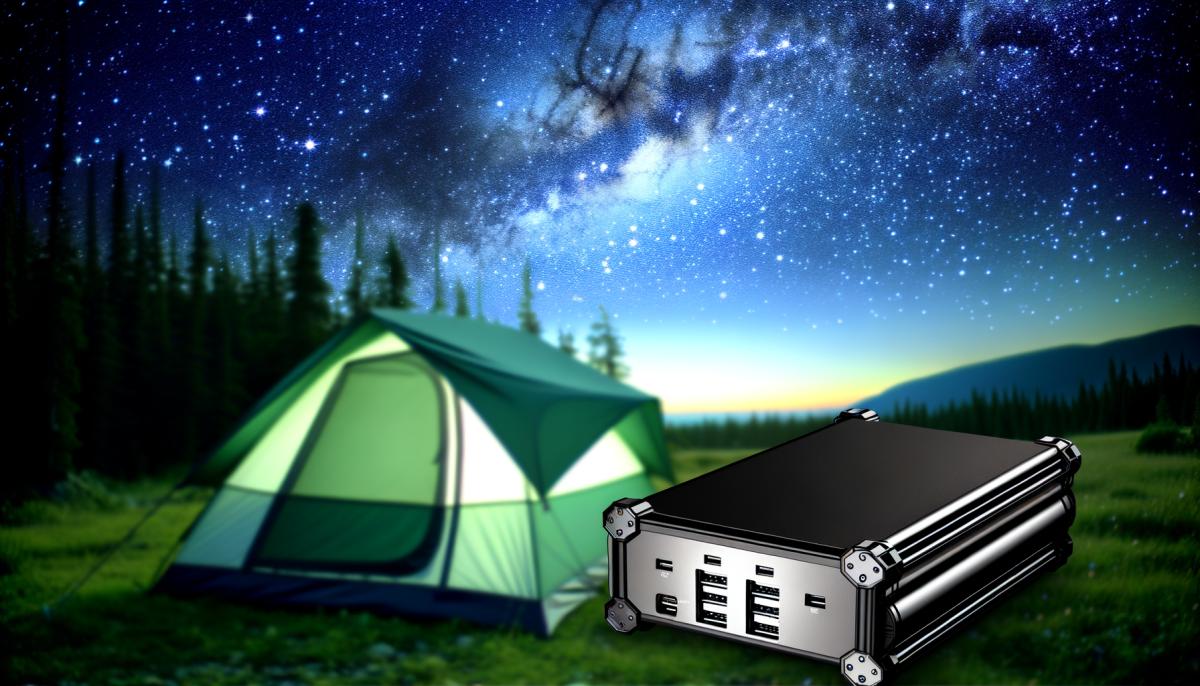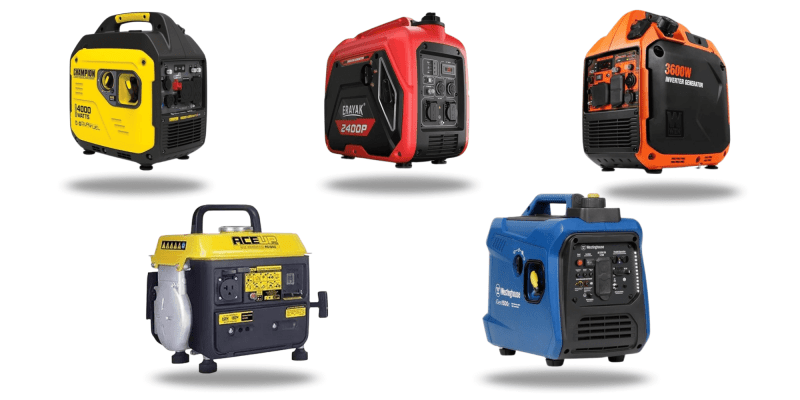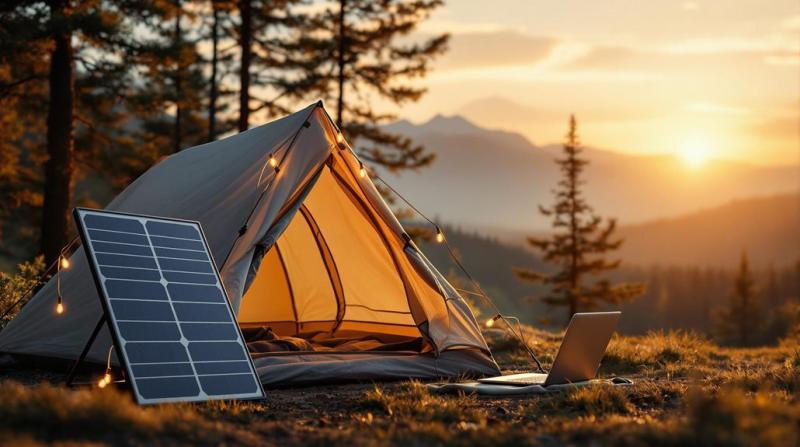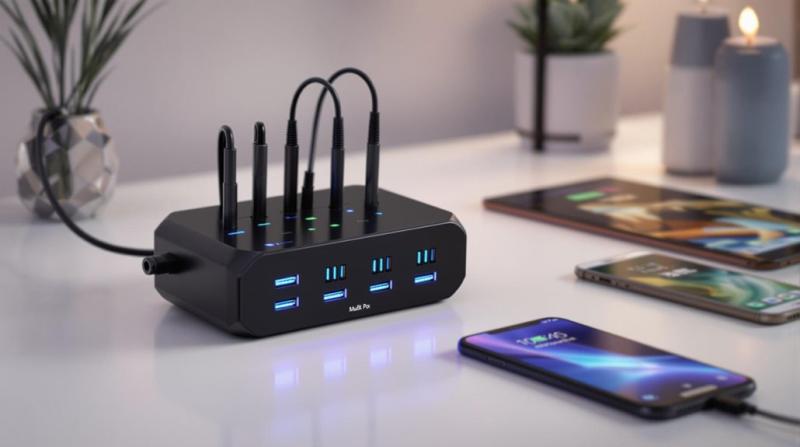Dependable portable power stations with extended battery life can truly enhance your outdoor adventures and emergency prep.
So, when you're on the hunt for one, pay attention to the battery capacity measured in watt-hours. This number tells you how long you can keep your devices going. You'll also want to check out features like multiple output options and fast charging capabilities.
Brands like Jackery and EcoFlow? Yeah, they're pretty much the rock stars of the portable power world. They're known for their reliable performance and cool, innovative designs. Plus, if you go for high-quality lithium-ion batteries, you're looking at greater longevity and efficiency.
Oh, and don't forget about maintenance! By following some simple maintenance tips and really understanding how you use your power station, you can make it last even longer.
So, dive in and explore more tips to pick the best portable power station for your needs.
Importance of Battery Capacity
Battery capacity is super important because it directly affects how long your portable power station can keep your devices running. This is key for planning outdoor adventures or emergency situations.
Picture this: you're out camping, hiking, or dealing with a sudden blackout. Knowing your power station's capacity can really give you peace of mind. It's like a safety net, ensuring your devices—from smartphones to camping gear—stay charged.
Imagine you're on a weekend camping trip and you need to keep a mini-fridge running. If your power station doesn't have enough battery capacity, you could end up with spoiled food or an uncomfortably warm tent. Not cool, right? So, it's crucial to think about your usual energy usage and pick a power station that can handle it.
Plus, power stations with higher battery capacities often come with neat features. We're talking multiple output types and the ability to charge several devices at the same time. This makes your investment way more valuable. You're not just charging one device; you're ready for all your energy needs.
Key Factors Influencing Battery Life
When you're using a portable power station, it's super important to get a handle on the key factors that influence battery life.
Seriously, understanding these can make a huge difference in performance. So, let's break it down: battery capacity, your usage patterns, and even environmental conditions all play big roles in how long your power station will keep going.
Think about it. By paying attention to these details, you can make smarter choices and really stretch out your battery's lifespan and efficiency.
It's all about being in the know!
Battery Capacity Considerations
Understanding key factors that influence battery capacity is crucial if you want to get the most out of your portable power station. When picking one, keep an eye on its amp-hour (Ah) rating. This tells you how much energy the battery can store.
Sure, higher Ah ratings usually mean longer usage periods, but don't forget to balance capacity with weight. Heavier batteries are a pain to lug around.
Now, let's talk about battery chemistry. Lithium-ion batteries are super popular because they're lightweight and efficient. But, they come with different life cycles. So, look for stations that have advanced thermal management systems.
These systems help keep the battery from overheating and extend its life. Also, features like Battery Management Systems (BMS) are great. They protect against overcharging and excessive discharging.
High capacity sounds awesome, right? But think about what you really need. Choosing a power station that fits your actual power needs helps you avoid unnecessary strain on the battery.
This way, it lasts longer. By paying attention to these details, you'll make sure your portable power station sticks around for years. In the end, being informed lets you make smarter choices and enhances your experience.
Usage Patterns Impact
Your usage patterns play a huge role in how long your portable power station lasts between charges. How you use it really influences its efficiency and longevity.
For instance, if you're constantly powering high-drain devices like power tools or larger appliances, you'll see the battery deplete quickly. But if you're just using it for lower-wattage stuff, like charging phones or running small lights, you'll help preserve battery life.
And hey, managing the load you put on your power station is super important too. Charging multiple devices at the same time? That makes the overall demand spike, causing quicker discharges. So, think about charging your devices one after the other instead of all at once. It can really extend your station's battery life.
Also, let's talk about how often you use it. Using your power station for short bursts consistently can keep it in a healthy cycle. But, letting it sit around for too long without use? That can lead to battery degradation.
And don't forget about charging habits! Frequent complete discharges can be harmful to lithium batteries. Try to keep your power station topped up when you can.
Environmental Conditions Effects
Environmental conditions really mess with battery life. Think about it—extreme temperatures and humidity can speed up wear and tear, making your battery perform worse.
So, when you're using your portable power station, keep an eye on your surroundings. If it's too hot, especially above 85°F (29°C), your battery might overheat. Overheating means reduced capacity and a shorter lifespan. On the flip side, if it's freezing, the cold can slow down the chemical reactions inside the battery and even cause permanent damage if you're not careful.
And let's not forget humidity. Too much moisture can corrode the internal parts of the battery, messing up conductivity and efficiency. You might think it's no big deal to store your power station in a damp place, but over time, that can lead to some serious power loss.
So, how do you keep your power station in good shape? Try to store it in a climate-controlled space. When you're outside, make sure it's protected from direct sunlight and bad weather. Regular maintenance and checks can also help extend its life.
Bottom line, being mindful of these environmental factors isn't just smart; it's essential for making sure your portable power supply stays reliable and efficient when you really need it.
Top Features to Look For
When you're out shopping for a portable power station, there are a few top features you really want to keep in mind.
Let's start with battery capacity. This is usually measured in watt-hours (Wh). Basically, the higher the capacity, the longer you can keep your devices running. So, if you're planning on powering multiple gadgets at once or need something to last a while, aim for a higher capacity. Think about what you'll be using it for—camping, RV trips, emergency backups—and choose a capacity that fits those needs.
Next up, let's talk about output versatility. You want a power station with a bunch of different output ports. We're talking AC outlets, USB-A, USB-C, even DC outputs. This way, you can charge anything from your smartphone and laptop to small appliances. Trust me, you don't want to be stuck with something that can't handle all your different devices. Versatility here is key.
And finally, don't forget about charging speed. A power station that charges up quickly can be a real lifesaver, especially in critical moments. Some models offer fast charging options that can get the battery fully juiced up in just a few hours. If you're always on the move and need to make the most of your downtime, rapid recharging capabilities are super important.
Recommended Portable Power Stations
So, you're in the market for a portable power station, huh? Awesome choice! These things can be lifesavers, whether you're planning an epic camping trip or just want a reliable backup for those unexpected power outages.
First things first, you gotta know what you're looking for. Not all power stations are created equal, and the best one for you really depends on what you need it for.
Now, don't just grab the first one you see. Take some time to compare the top brands out there. Each one has its own set of features and quirks that might be perfect for your situation—or not.
Top Features Overview
Alright, let's talk about what makes a portable power station truly reliable.
First things first, you've got to think about capacity. This is basically how long the power station can keep your devices running, and it's measured in watt-hours (Wh). So, when you're picking one out, make sure it has enough juice to cover your regular use. Whether you're heading out for a camping trip or prepping for a power outage, capacity is key.
Now, let's chat about output options. You definitely want a variety here. Think multiple ports: AC outlets, USB ports, DC outputs—you name it. This way, you can charge anything from your smartphone to small appliances. A mix of these ports is ideal, giving you that sweet versatility we all crave.
Don't forget about portability! You're going to want something that's easy to lug around. Pay attention to the weight and size. A lightweight, compact design is a game-changer. And hey, if it has built-in handles or wheels, even better! Makes travel a breeze.
Oh, and let's not overlook the extra features. Fast charging is a big plus, as are integrated safety systems and a user-friendly interface. These little bonuses can make a huge difference. Focus on these top features, and you'll end up with a power station that's perfect for your needs. Whether you're out in the wild or dealing with an emergency, you'll be all set.
Best Brands Comparison
In the crowded market of portable power stations, three brands consistently stand out for their reliability, performance, and user-friendly features: Jackery, Goal Zero, and EcoFlow. Each brand offers unique advantages, catering to different needs and preferences.
So, let's talk about Jackery first. It's often praised for its lightweight design and portability, making it an excellent choice for outdoor adventures. Users absolutely love its easy-to-read display and intuitive controls, which make operation a breeze. And let's not forget Jackery's extensive range of solar generators—perfect for harnessing renewable energy effectively.
Now, switching gears to Goal Zero. This brand is all about versatility. Their power stations can handle a variety of devices, from phones to small appliances. The Yeti series is super popular among campers and road-trippers, thanks to its robust build and thorough accessory options. Basically, it ensures you've got everything you need on your trips.
And then there's EcoFlow. This brand has made waves with its rapid charging capabilities and high-capacity batteries. If you need a power station that'll charge quickly and keep running for long periods, EcoFlow's products are definitely worth considering.
Usage Scenarios Explained
Understanding how to effectively use portable power stations can really boost your outdoor experiences, like when you're camping, tailgating, or prepping for emergencies.
Picture this: you're heading out for a weekend camping trip. Having a reliable power station means you can charge your devices, run a small fridge for your snacks, and even power lights at night. This kind of versatility can totally transform your enjoyment of the great outdoors.
When it comes to tailgating, a portable power station can really amp things up. You can easily power grills, speakers, and even a mini-fridge to keep your drinks cold. This kind of convenience not only makes the experience better but also keeps the party vibe going strong without worrying about finding traditional power sources.
And let's talk emergencies. A portable power station can be a real lifesaver. It can keep medical devices running during power outages or power up communication devices to keep you connected when it counts the most. By choosing a dependable power station, you're making sure you're ready for anything that comes your way.
Real-World Usage Scenarios
Portable power stations are super handy for charging your devices during camping trips, emergencies, or outdoor events. They really show their practical value in everyday life. Just think about how a power station could totally change your camping experience. Picture this: you're deep in the wilderness, and your phone needs charging—not just for calls, but to access maps or emergency services. With a portable power station, you can relax knowing your devices will stay powered up.
In emergencies like power outages, these portable power stations can be real lifesavers. Instead of running around looking for candles or flashlights, you can set up your power station in no time to keep essential devices running. Imagine having your refrigerator still working to keep food fresh or powering medical equipment that someone might rely on. This ability to keep critical power going can really ease discomfort and reduce risks during unexpected events.
Outdoor events? Oh, they benefit a ton from these devices too. Whether you're hosting a backyard barbecue or tailgating before a big game, having a portable power station means you can play music, charge your speakers, and power up electric grills without stressing about finding an outlet. It just makes everything more fun and convenient.
In all these scenarios, the reliability and portability of power stations really stand out. They don't just provide power on demand; they make your overall experience better. They're pretty much indispensable in today's fast-paced world. So, investing in a reliable portable power station is a smart move for anyone who values staying connected and having convenience, no matter where you are.
Maintenance Tips for Longevity
To guarantee your portable power station stays reliable for all those camping trips and emergencies, regular maintenance is key to maximizing its lifespan and performance.
First off, keep the power station clean. Dust and debris can build up over time, affecting airflow and efficiency. Just use a soft cloth to wipe down surfaces regularly, and make sure the vents are unobstructed.
Next, charge your power station regularly, even if you aren't using it. Lithium-ion batteries benefit from partial discharges and frequent charging. Ideally, keep the battery level between 20% and 80%. And hey, don't store your unit in extreme temperatures. That can really degrade battery life. So, find a cool, dry place for long-term storage.
Oh, and don't forget to inspect cables and connections periodically. Damaged cords or loose connections can result in poor performance. If you see any frayed or damaged cables, replace them immediately. You definitely want to avoid overloading the power station, too. Check the specifications to make sure you're within safe operating limits. This won't only protect the device but also guarantee maximum efficiency.
If you notice any unusual behavior, like rapid battery drainage or strange noises, address the problem promptly. This proactive approach can help you avoid bigger issues down the line.
Comparing Battery Technologies
When you're looking into battery technologies for your power station, you've got to think about how different chemistries like lithium-ion, lead-acid, and lithium iron phosphate compare in terms of efficiency, lifespan, and weight.
Alright, let's start with lithium-ion batteries. These guys are top-notch when it comes to efficiency. They've a high energy density and a longer lifespan, typically around 2,000 cycles. So, you can rely on them for a long time without needing replacements. Sure, they cost more initially, but their durability and performance usually make up for that.
Now, let's talk about lead-acid batteries. They're the cheapest upfront, but they mightn't be the best investment in the long run. Usually, they only last about 500 cycles, and they're pretty heavy, which can be a pain if you need to move them around. If you're mainly thinking short-term or you're on a tight budget, they might seem okay. But if you need something for frequent use, their inefficiency could end up costing you more overall.
Then there's lithium iron phosphate (LiFePO4) batteries. These are kind of a sweet spot. They've better safety features, good thermal stability, and about 2,000 cycles, just like lithium-ion batteries. They're more expensive than lead-acid, but they handle deep discharges better, which makes them great for heavy-duty applications.



